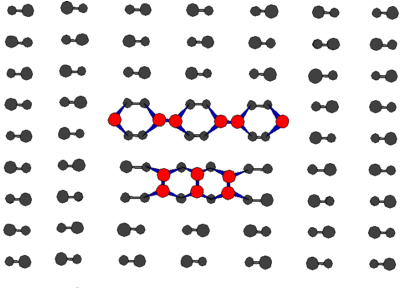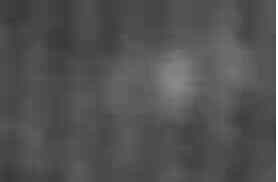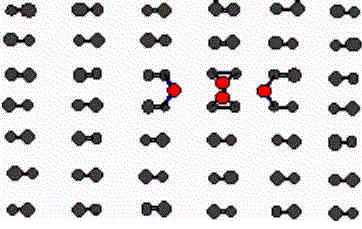Fig.12 Dense and Dilute Row Fundamental
Units. The top feature imaged is a
dilute row and the bottom feature is a dense row. The
dilute row may be regarded as a chain of type C dimers
plus two monomers, or a cross plus a dimer at one end. It
images as a pair of crosses. Since the Si (001)-2 × 1 reconstructed
surface is built of dense rows; the properties of such
rows is of great interest to those studying silicon
growth. For the same reason, if and how dilute rows
evolve into dense ones are also interesting questions.
|
 Fig.13 Filled vs. Empty State Images of
a Dilute Row. The empty state image
reveals the end monomers depicted in Fig. 12's diagram.
|
 Fig.14 Filled vs. Empty State Images of
a Dense Row. Focusing on the end of a
dense row (which extends out of the image to the right),
one can see the lengthwise splitting of the row in the
empty state image. This reflects the orientation of the
two dangling bonds of each of the dimers which comprise
the row. These dangling bonds are depicted in the
schematics of Figs.1A
and B. The
slight skewing of the image is due to sample drift during
imaging.
|
Fig. 15. Tie-Cross-Dense Row
Conversion. The first two steps of this
short involve an A to C-dimer conversion, and back.
Unlike with the Stealth conversion in Fig. 5, the central
dimer is accompanied by two monomers which presumably
anchor it and prevent diffusion along the row. In the
last step another pair of atoms joins the original four
and a dense row is formed. The procession of
configurations is Tie to Cross to Tie to Dense Row. More
images and information about the Tie and Cross
configurations are available on the Two
Dimer Configurations
page of the Gallery. This is an excerpt from a longer
movie that will be available for viewing at a later date.
Image Rate= 1/min.; Temperature= 441K.
|





